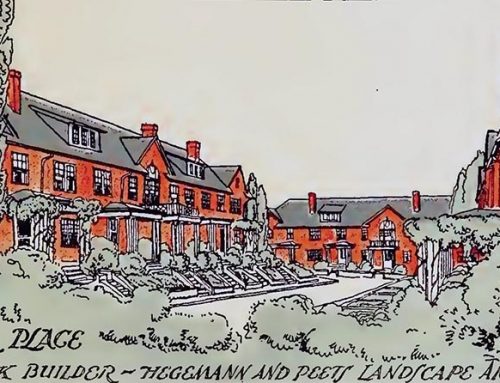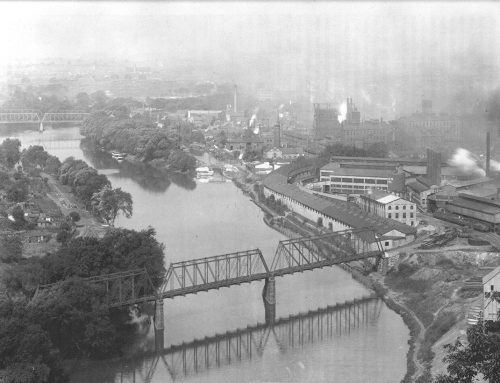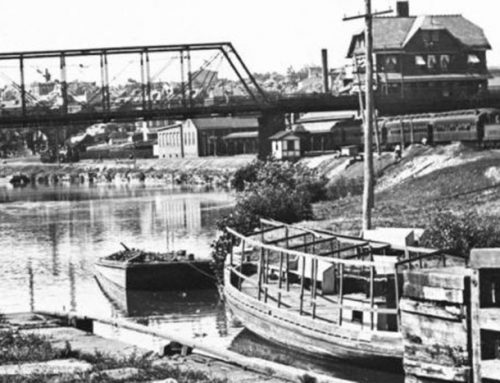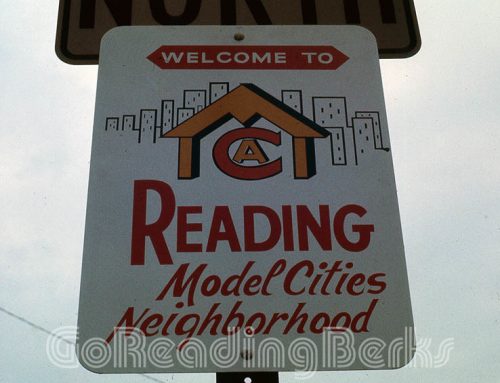In 1864, Frederick R. Frill purchased from William Leinbach a farm of 116 acres. In 1873, he laid this land off into lots, and most of the lots in the blocks south of Penn Avenue and east of present-day Fifth Avenue were numbered consecutively from 1 to 200. The surveyor was Daniel S. Zacharias, who prepared the draft, dating it Oct. 21, 1873.
Below: Map of West Reading, 1876.

Mr. Frill sold many of these lots during the summer of that year, and delivered the deeds in October. The first purchaser was James F. Matz, a carpenter, who erected a large three-story brick building at the southeast corner of Second and Penn, which became the Farmers’ Hotel – not to be confused with the well-remembered West Reading Hotel that earlier had been called the Farmers and Drovers Hotel.
The first row of dwelling-houses was erected in 1873 on Franklin street, between Third and Fourth streets, by Abraham F. Reeser and William Geiger, of Reading.
In 1883, George F. Baer, Charles F. Smith and Reuben E. Demmon laid off into lots a considerable part of the Jacob W. Seitzinger farm which they had purchased, and the first blocks of lots then sold lay between Fifth and Sixth streets, south of West Penn avenue to Spruce street.
Soon thereafter, George J. Eckert (1827-1900), manufacturer of fire brick in Reading, purchased the large lot that fronted along Penn Avenue between Second and Third where the Penn View Motel was once located and built what was probably West Reading’s most impressive mansion.
Below: Eckert Mansion.

George Eckert built the place as “a suburban mansion” in 1876. In its heyday, it had 22 charming rooms, a fine garden, vineyard, and all kinds of choice fruit. Eckert was born in Lebanon County, graduated from Marshall College, practiced law locally from 1855 to 1865, and was a particularly successful manufacturer of fire brick. Miss Ella and R. Ressley Eckert were the last Eckerts to reside in the mansion; they moved to 460 Chestnut Street, West Reading, in 1920. After the State Police vacated the premises, it became an apartment house which it remained until razed in July 1964 to make way for Penn View Motel.
According to historian Morton L. Montgomery, William E. S. Hinnershitz, the town’s first resident merchant, established a grocery store at 5 Penn Ave. in 1880.
Four years later, Stephen S. Wisser started a general merchandise emporium at what was then numbered 24 Penn Ave. In time, Wisser occupied three adjoining three-story houses for business purposes, which included a furniture department.
On June 23, 1892, Wisser became West Reading’s first postmaster. The post office was in his store. On July 21, 1899, Wisser was succeeded by Charles M. Schaeffer, who also kept a general store, at 546 Penn Ave. Schaeffer retained the office only a few weeks. William H. Tyson, a barber at 46 Penn Ave. assumed the position on Sept. 6, 1899.
On April 28, 1904, Harry B. Blankenbiller, part owner of Blankenbiller Brothers’ general store, southeast corner of Fifth and Penn avenues, became postmaster. He continued in that capacity until the West Reading post office was discontinued on Dec. 31, 1915.
Below: In 1907, the year West Reading became a borough, Harry B. and Daniel B. Blankenbiller operated a general store and conducted the West Reading Post Office on the southeast corner of Fifth and Penn Avenues. A Subway now occupies the site. Directly behind was George M. Hain’s blacksmith shop and carriage works. The borough schoolhouse stands high in the background along Fifth Ave., between Grape and Chestnut.


To accommodate the growing number of school-age children in the West Reading area, school directors of Spring Township erected a commodious eight-room schoolhouse at the northeast comer of Fifth Avenue and Chestnut Street, in 1898, at a cost of $20,000. When West Reading Borough was formed, “damage costs” were paid to Spring Township to acquire the building, which was in service until 1953. Razing ensued the following year. A playground now occupies the site.
Below: Former West Reading Schoolhouse and present day playground along Fifth Ave., between Grape and Chestnut.


After the town of West Reading had come, through the course of thirty years, to be a flourishing community, with a number of important industries and an estimated population of 700, steps were taken in March 1903 to establish a borough, but the remonstrance of many property holders was so vigorous during the course of six months that the proceedings were dropped.
A second effort was made in November 1906, with the conditions greatly improved, and though earnest objections were again presented, the court made the decree of incorporation on March 18, 1907.
The boundary lines enclosed 373 acres, extending from the Wyomissing Creek on the south to the Lebanon Valley Railroad on the north, and from the western bank of the Schuylkill River on the east to the eastern boundary line of the borough of Wyomissing on the west.
The first public election was held May 7,1907, when the first borough officials were elected. F. R. Himmelberger, a prominent carriage manufacturer of the town for upward of twenty years, was chosen the first burgess, and this election started the community in its political career as a separate district.






Leave A Comment